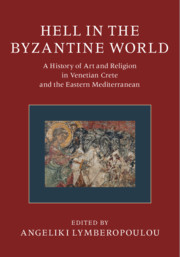 Hell in the Byzantine World
Hell in the Byzantine World Book contents
- Hell in the Byzantine World
- Hell in the Byzantine World
- Copyright page
- Dedication
- Dedication
- Contents
- Figures and Maps
- Preface
- Acknowledgements
- Editorial Policy
- Volume 1
- Introduction
- Part I Crete
- Part II Eastern Mediterranean
- 5 When the Visual Order Was Established
- 6 Damned in Hell, Damned in the Church
- 7 Images of Hell and the Afterlife in the Churches of Lakonia
- 8 Hell in the ‘Sweet Land’
- Volume 2
- Bibliography
- Index
8 - Hell in the ‘Sweet Land’
Hell’s Place in the Last Judgements of Byzantine and Medieval Cyprus
from Part II - Eastern Mediterranean
Published online by Cambridge University Press: 02 October 2021
- Hell in the Byzantine World
- Hell in the Byzantine World
- Copyright page
- Dedication
- Dedication
- Contents
- Figures and Maps
- Preface
- Acknowledgements
- Editorial Policy
- Volume 1
- Introduction
- Part I Crete
- Part II Eastern Mediterranean
- 5 When the Visual Order Was Established
- 6 Damned in Hell, Damned in the Church
- 7 Images of Hell and the Afterlife in the Churches of Lakonia
- 8 Hell in the ‘Sweet Land’
- Volume 2
- Bibliography
- Index
Summary
Annemarie Weyl Carr examines the shifting imagery of post-mortem punishment in twenty-two depictions of the Last Judgment on Cyprus. The earliest versions, dating from the 12th through mid-14th century, cover three-dimensional, vaulted interiors. Centred on Christ, with degrees of punition arranged around him to contrast with either one another or beatitude, they present punishment as a range of conditions, not a place. The next group, dating from the mid-14th through the 15th century, are organised bilaterally around the scale of judgment, thus creating a clear differentiation between redemption and condemnation. Condemnation, however, remains chaotic, a state of being cast out, not a destination to which one goes. The final images, dating from the late 15th and16th centuries, occupy a single surface each. The Last Judgment may hover as a prophetic future, engulf as a wrap-around panorama, or spread in a landscape, but in each case, the events of punishment are in some way accorded a defined place. Thus, the Cypriot churches show a growing tendency to attribute spatial qualities to Hell. This space, however, embracing the whole of morality from sin and death through resurrection and judgement to damnation, has little in common with the Hell of western European art.
- Type
- Chapter
- Information
- Hell in the Byzantine WorldA History of Art and Religion in Venetian Crete and the Eastern Mediterranean, pp. 346 - 411Publisher: Cambridge University PressPrint publication year: 2020
- 2
- Cited by


